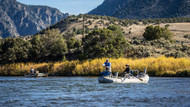5 Tips to Catch More Fish This Fall: A Guide’s Perspective

Fall is one of my favorite times of year to be on the water. The air cools, the leaves change, and the rivers settle into low, clear flows. These conditions might intimidate some anglers because trout can get skittish when the water thins out, but for those of us who know how to approach the season, fall presents incredible opportunities. The fish are hungry, aggressive, and on the hunt for high-calorie meals before winter sets in. With the right strategy, you can extend your season, catch more fish, and soak up the best scenery nature has to offer.
As a guide, I’ve spent countless autumn days watching how trout respond to these conditions, and I’ve learned that a few adjustments make all the difference. Below are five tips I always share with clients to help them catch more fish in Fall.
1. Streamers for Aggressive Fall Fish
One of the most exciting things about fall is the spawn. Brown and brook trout, along with Rocky Mountain whitefish, spawn during this season. Spawning makes them territorial and more willing to attack intruders in their space. That’s where streamers shine.
I tell my clients to think like a predator this time of year. Trout are less interested in sipping tiny midges and more focused on big, meaty meals—sculpins, leeches, and baitfish. Streamers imitate these perfectly. Cast them tight to the banks, strip them with purpose, and be ready for violent takes.
Cloudy or overcast days are especially good for streamer fishing because the fish feel less exposed in the dim light. Don’t be afraid to experiment with retrieve speeds—sometimes a fast strip triggers a reaction, while other times a slow, steady pull convinces a trout to commit. Either way, streamer fishing in the fall is some of the most heart-pounding action you can have all season.
2. Mind Your Shadow
With the sun sitting lower in the sky during autumn, your shadow becomes a bigger factor than many anglers realize. A long shadow cast across the water is enough to send fish bolting for cover.
Before you step into position, take a moment to look at the light. Where’s the sun? Where’s your shadow falling? Adjust your approach so that your silhouette doesn’t fall across the run you’re planning to fish. Sometimes that means wading in from downstream instead of upstream, or sneaking along the bank to stay out of sight.
As guides, we live by the mantra of “stealth first.” In fall’s clear water, trout can see everything, so staying mindful of your shadow is one of the simplest, yet most effective, ways to improve your odds.
3. Fish When the Water Warms
Fall mornings can be crisp, and overnight lows often drop water temperatures to their lowest point of the day. Trout metabolism slows down in those colder temps, meaning they won’t feed as aggressively at first light.
That’s good news for anglers who like to sleep in a bit. There’s no need to rush to the river at dawn. Instead, plan your trip to hit the water mid-morning or early afternoon when the sun has had a chance to warm things up. Once the water climbs above 42°F, trout activity increases dramatically.
I often tell my clients to think of fall fishing as a late breakfast or lunch session. Fish use that bump in temperature as their cue to feed, and that’s when you’ll find the most consistent action.
4. Eggs: Nature’s Protein Bombs
If there’s one fly you should always have in your fall box, it’s an egg pattern. With browns, brooks, and whitefish spawning, there’s no shortage of loose eggs drifting through the current. To trout, these are little nuggets of pure protein—easy to spot, easy to eat, and packed with energy for the leaner months ahead.
I like to pair an egg pattern with a small nymph in a tandem rig. The egg grabs attention, while the trailing fly looks like a natural insect or larva drifting nearby. Together, they make an irresistible combo.
Just remember: respect the spawning fish. Avoid targeting trout that are actively on redds (the cleaned gravel beds where they lay eggs). Instead, focus on the hungry fish holding downstream, waiting for loose eggs to drift by. That way, you’ll have plenty of action while protecting the future of the fishery.
5. Stealth Is Non-Negotiable
Low, clear flows mean trout see better than almost any other time of year. They pick up on every movement, every shadow, and every disturbance in the water. That’s why stealth is absolutely critical.
When approaching a run, I tell clients to go “low and slow.” Crouch or kneel if you have to. Move quietly. Choose earth-toned clothing that blends into your surroundings. Avoid splashy casts or stomping through the shallows.
If you treat every pool like it’s holding the fish of a lifetime, you’ll find yourself catching more and spooking less. Fall rewards patience and careful approaches far more than brute force or quick movements.
Wrapping It Up
Fall fly fishing is about more than just catching fish—it’s about experiencing rivers in their most stunning season. Golden leaves drift on the current, crisp air sharpens your senses, and the fish themselves are some of the most beautiful of the year, dressed in vivid spawning colors.
By focusing on aggressive streamer tactics, paying attention to shadows, fishing at the right temperatures, drifting egg patterns, and moving with stealth, you’ll give yourself the best chance to succeed. These tips are simple, but they come from years of watching fish behavior and guiding anglers through the challenges of low, clear flows.
So don’t hang up your rod when summer ends. Get out there this fall, apply these techniques, and enjoy some of the most rewarding fishing the season has to offer.







